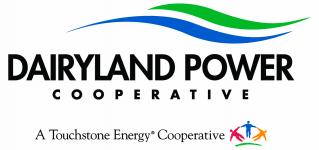2020s
2023
- Ben Campbell (Environmental Biologist) and Brad Foss (Director, Environmental and Compliance) were awarded the 2023 Electric Power Research Institute's (EPRI) Technology Transfer Award for Novel Application of Traveling Screens for Fish Protection, resulting from the JPM Traveling Water Screen Optimization Study.
- The Midcontinent Independent System Operator (MISO) named Dairyland to develop, own and operate a new 345-kilovolt (kV) transmission line (Alma-Blair Transmission Project) from the Mississippi River to the Tremval (Blair, Wis.) Substation.
- An "Internet for All" roundtable was hosted at Dairyland featuring Tom Perez, Senior Advisor & Assistant to the President/White House Director of Intergovernmental Affairs, and Don Graves, U.S. Deputy Secretary of Commerce. Roundtable participants shared how reliable internet access will directly expand opportunities for local communities.
- More than 120 volunteers from Dairyland and 12 of its member cooperatives participated in six community service projects (over 600 hours of work time) on Oct. 4, for Dairyland's 1st annual Cooperative Day of Service. Sites were: Alma, Wis.; Elk Mound, Wis.; Holmen, Wis.; Prairie du Chien, Wis.; Rushford, Minn.; and Tony, Wis.
- The U.S. Department of Energy (DOE) awarded Dairyland a $5.7 million grant for a long-duration energy storage project located in Allamakee County, Iowa, to serve Allamakee-Clayton Electric Cooperative members. The planned Invinity Energy Systems vanadium flow battery (VFB) is capable of discharging 700 kW to 3.6 MW of electricity for up to 20 hours.
- A Letter of Interest for funding through the USDA's Empowering Rural America (New ERA) grants program was submitted. Dairyland's proposal included eight solar and four wind energy projects in Wisconsin, Iowa and North Dakota.
- Dairyland hosted its inaugural JPM Charity Golf Event to benefit first responders at The Grove Golf Course (Cochrane, Wis.). More than $5,000 was raised.
- In July, April Wehling was named EVP/Chief Financial Officer, replacing Phil Moilien after he retired.
- JPM was brought back online after a 10-week outage to overhaul the turbine and generator, and upgrade the precipitator equipment, which doubled the amount of fly ash collected during the coal combustion project. Collected fly ash is sold and recycled as an additive to cement and concrete applications - being used in the roundabout construction project near Dairyland's La Crosse office.
- Dairyland was awarded a $14.89 million Middle-Mile Broadband Infrastructure Grant in June. With the award, Dairyland will retrofit 240 miles of transmission lines with optical ground wire (OPGW) during its Tri-State Fiber Deployment Project to expand internet access in underserved and rural communities.
- Miss America (and former Miss Wisconsin) Grace Stanke was the keynote speaker at Dairyland's 2023 Annual Meeting on June 7, at the La Crosse Center. Stanke's keynote discussed, "Energy Advocacy Beyond the Midwest: How the Culture of Wisconsin Influenced My Future."
- Dairyland's Annual Report - ALL IN - was designed and printed at Powered Printing - a service of Dairyland Power Cooperative.
- As the summer kicked off for students in Wisconsin, Dairyland celebrated its 20th year of supporting the WIAA State Track & Field Championships in La Crosse, Wis.
- On May 4, Dairyland announced its collaboration with Mine Storage International AB and Michigan Technological University to explore the potential for pumped storage hydropower.
- Dairyland was named a 2023 CIO 100 Award Winner by Foundry's CIO for delivering business value through innovation with our Dairyland Systems Modernization (DSM) program.
- After more than 30 years of continuous operation, Dairyland's System Operations Center was remodeled and the tile mapboard replaced by a multifunctional video wall.
- In March, the U.S. Nuclear Regulatory Commission (NRC) formally transferred the license for the La Crosse Boiling Water Reactor (LACBWR) site in Genoa back to Dairyland.
- Dairyland Vice President, Strategic Growth John Carr was in Washington D.C., the end of February testifying before the U.S. House of Representatives Committee on Natural Resources about modernizing the permitting process during discussions on the BUILDER Act.
- To enhance employee safety and system reliability, Dairyland purchased a 100' Altec tracked bucket truck for Transmission Construction and Transmission Maintenance crews, and two additional Jarraff all-terrain vehicles for Vegetation Management crews.
- The new year kicked off with Dairyland acquiring 10 wholesale power supply customers: Great Lakes Utilites and nine of its member communities.
2022
- RockGen Energy Center and Elk Mound Generation Station both reached their second-highest annual generation records in 2022, while achieving industry top quartile in plant availability.
- VEIT Co., safely felled the baghouse at Genoa Station #3 on Dec. 29. VIDEO
- Winter storms and frigid temperatures led to a new Dairyland winter peak load of 1,038 MW on Dec. 22.
- In August, Dairyland became Great Place to Work® Certified. The award is based entirely on what current employees said about their experience working at Dairyland via an all-employee survey. In January, the U.S. Department of Veterans Affairs approved Dairyland as a GI Bill® Training Facility.
- In July, Dairyland purchased a Ford E-Transit cargo van - a fully-electric van with 120-miles of range utilized by the Publication Services team for daily deliveries.
- Dairyland hosted its 2022 Annual Meeting at the newly-renovated La Crosse Center on June 8 with the meeting theme Laser Focused.
- A ribbon cutting event was held on May 12 for a new service center in Harmony, Minn. The 23,000 sq. ft. facility is located on 10 acres with three acres of pollinator habitat around the site. The service center is a regional base of operations for area line and electrical maintenance crew members.
- During decommissioning and dismantlement at Genoa Station #3, local community organizations benefited. DeSoto (Wis.) High School received laboratory equipment and Eleva-Strum (Wis.) School District received equipment from the maintenance shop. Additionally, multiple donations to Habitat for Humanity's ReClaim Salvage Program diverted more than 50,000 lbs of materials from landfills and were expected to raise more than $30,000 for the La Crosse Area Habitat for Humanity via sales at ReStore.
- On Earth Day, the first fast charger at a Kwik Trip in the State of Wisconsin was dedicated at the newest Holmen Kwik Trip (1760 Tempte St.). Dairyland funded and assisted with the Level 3, 180-kW ABB fast charger, which is served and owned by member Riverland Energy Cooperative (Arcadia, Wis.).
- On Feb. 24, Dairyland and NuScale Power signed a memorandum of understanding to evaluate the potential deployment of NuScale's small modular reactor technology and support Dairyland's due diligence process in evaluating affordable, reliable and carbon-free energy solutions.
2021
- NASA dubbed a Dec. 15 derecho (windstorm associated with an unusually strong and fast-moving line of thunderstorms) "anomalous and historic" as it created widespread damage among Dairyland's southeast Minnesota/northeast Iowa cooperatives' service territories. The Wednesday night storm damaged 70 Dairyland structures plus four telecommunications towers. Dispatched crews had the Dairyland system fully restored by Sunday afternoon.
- On Aug. 26, Dairyland announced it entered a purchase agreement to acquire the 503-megawatt (MW) RockGen Energy Center, a natural gas power plant located in Cambridge, Wis. The formal acquisition occurred on Dec. 15, 2021.
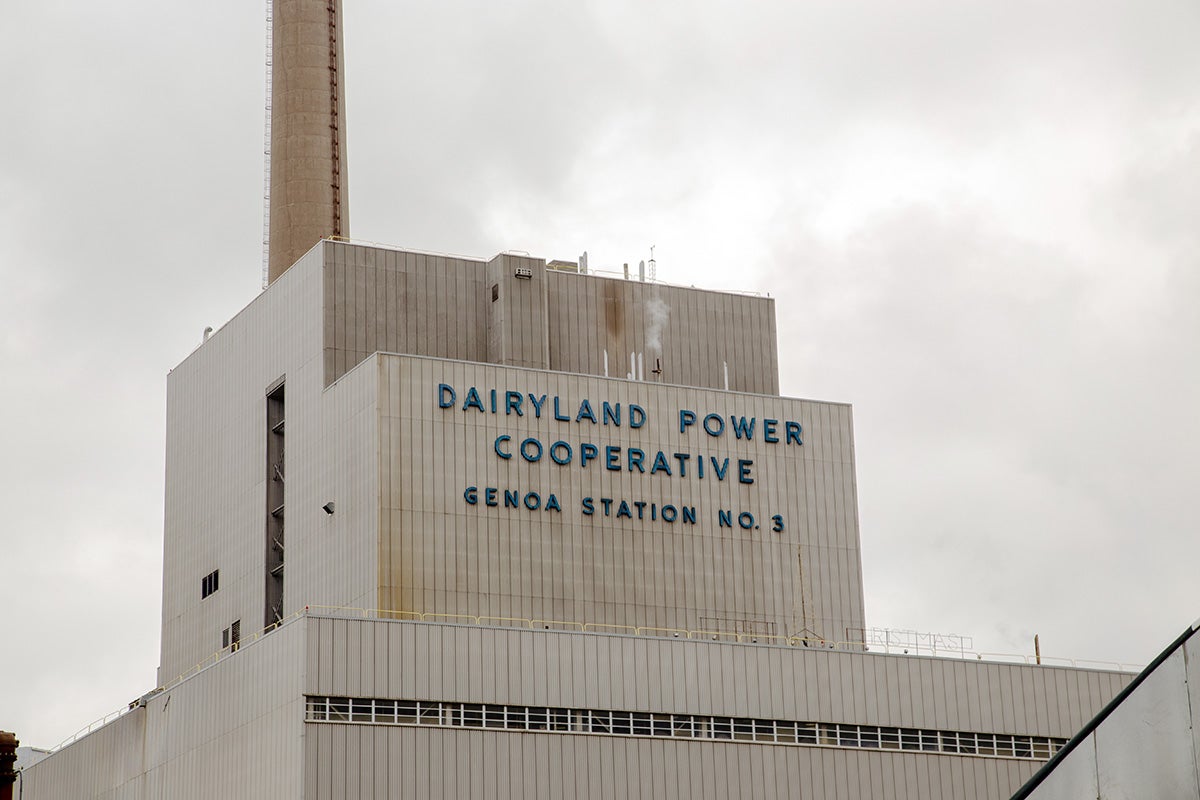
- June 1 was the official retirement date of the 345-megawatt (MW) Genoa Station #3 coal-fired power plant. G-3 provided safe, reliable power to the region for nearly 52 years. It's last day of operation was April 11, following depletion of the usable coal inventory.
-
Dairyland hosted U.S. Secretary of Labor Marty Walsh on May 25. Also in attendance were U.S. Congressman Ron Kind, local elected officials and representatives from labor and business. President and CEO Brent Ridge, as well as Technical Training Manager Julie Schultz were among speakers at the event.
-
The original 10 CapX2020 utilities renamed their organization Grid North Partners. The group will continue to collaborate to meet the region's evolving energy needs. In 2020, the group published a 2020 Vision Report, which identified the need for new transmission infrastructure as the region's energy mix shifts.
-
There were no injuries following a fire on the fan room roof of the John P. Madgett power plant in Alma, Wis., on Feb. 26. Local fire departments responded to the fire, which did not impact plant operations.
-
Dairyland's generation fleet performed reliably during a February Polar Vortex that paralyzed the grid in Texas (ERCOT) and caused rolling blackouts for the neighboring Southwest Power Pool (SPP). Dairyland's JPM plant broke gross daily generation records on Feb. 8 and Feb. 17. JPM, G-3 and Weston #4 ran at peak output for multiple days; Elk Mound switched to fuel oil for operations as natural gas prices rose due to high demand for home heating.
-
The Tatanka Ridge Wind Farm (Deuel County, S.D.) is energized. Dairyland has a power purchase agreement for 52 MW of the 154.8 MW facility. Dairyland's portion is expected to power about 16,000 homes.
2020
-
In 2020, Dairyland recycled 100 percent of the fly ash captured by precipitators at Genoa Station #3 and the John P. Madgett (JPM) power plants. Dairyland's fly ash is most commonly recycled as a replacement for Portland cement in concrete. This was the first time Dairyland achieved the 100 percent milestone at both facilities.
-
CHARGE EV, LLC, is formed by a group of 31 electric cooperatives (including Dairyland). CHARGE will support installation of public chargers in co-op service territories and invest in electric vehicle education for members, dealerships, contractors and others.
-
Dairyland hosted U.S. Vice President Mike Pence and Secretary of Labor Eugene Scalia on Labor Day to honor the critical service our employees provide for the cooperative membership. President and CEO Brent Ridge, U.S. Sen. Ron Johnson and Wisconsin Manufacturers & Commerce (WMC) President & CEO Kurt Bauer also spoke at the official visit, which was attended by Dairyland employees and their family members who wished to participate.
-
A groundbreaking ceremony for the new Publication Services building was held on June 9. The 9,032 square-foot building will be equipped with state-of-the-art publication facilities to serve more than 100 customers, and will be home to Dairyland's printing, graphic design and mail services team. The department moved into the building - located just south of the La Crosse Service Center on East Avenue in La Crosse - right before Thanksgiving 2020.
-
The region learned what 'derecho' means when severe storms tore through the region in August. Dairyland crews supported Central Iowa Power Cooperative (CIPCO) in power restoration efforts. Winds reached 100 mph and knocked out power to 60,000 cooperative members across Iowa. Dairyland crews replaced 220 poles across two sections of line for CIPCO.
-
On July 13, Brent Ridge is announced as Dairyland Power Cooperative's seventh President & CEO, taking over for Barbara Nick who led Dairyland since 2015.
-
On March 15, Dairyland activated its Business Continuity Plan for the first time, ever, to address the emerging COVID-19 pandemic. Employees immediately postponed or canceled in-person meetings and travel; 269 employees transitioned to working from home. What was estimated to be a two-week move turned into most employees working from home full time until July 2021.
2010s
2019
-
A power purchase agreement was finalized with Avangrid Renewables, LLC, for 52 MW of renewable energy from the proposed Tatanka Ridge Wind Farm.
-
The first weekend in May, Dairyland sponsored several events and activities for Wisconsin's 54th Governor's Fishing Opener, which was held in Rusk County. Ladysmith was the hub for the weekend's activities with fishing on the Dairyland Reservoir. Dairyland's Flambeau Hydroelectric Station crew (Dee John Dupee, Dennis Arendt and Harley Ripke) hosted public tours of the facility, including a private tour for Gov. Tony Evers.
-
Winter Storm Wesley brought blizzard conditions to Dairyland's service territory in April. The storm damaged more than 100 transmission structures with 25 distribution substations out of service in Dairyland's service territory. Over 50 Dairyland crew and staff members responded to Restoration of Power in an Emergency (ROPE) requests.
-
Dairyland finalized a power purchase agreement with Ranger Power to purchase the entire output of a planned 149-MW Badger State Solar Project. The project is expected to generate enough renewable energy to power more than 20,000 homes and will feature pollinator habitat under the array. The facility will be located in the Towns of Jefferson and Oakland in Jefferson County, Wis.
2018
-
The 700-foot stack of Dairyland's Alma Station (Units 1-5) was safely demolished on Oct. 1, utilizing 303 lbs. of dynamite in 418 holes bored into the cement stack. The main building was brought down in 2017; the stack was the last structure to be removed. The JPM station remains at the Alma Site.
-
Western Wisconsin's first electric vehicle charging hub was dedicated on Sept. 6, at the Ground Round Grill & Bar in Tomah, Wis. The DC fast-charging station and two Level 2 charging ports were made possible in part through the Michigan-to-Montana I-94 Clean Fuel Corridor project, Dairyland Power Cooperative, Oakdale Electric Cooperative and the Tomah Ground Round Grill & Bar.
-
Dairyland announces the addition of three more utility-scale solar arrays, for a total of 18 sites with 25 MW of generation capacity in each of the four states of the Dairyland system. Together the sites will be able to produce enough renewable energy to power nearly 4,000 homes. Each site will also feature a pollinator meadow under the panels.
-
Quilt Block Wind Farm is named RENEW Wisconsin's 2017 Project of the Year.
2017
- Dairyland and EDP Renewables dedicate the 98 MW Quilt Block Wind Farm (Darlington, Wis.). Dairyland will execute a power purchase agreement with EDPR for the entire electric output of the wind farm, which is expected to produce enough electricity to power more than 25,000 homes.
- Plans for a renewable-energy enabling 525-550 MW combined cycle natural gas facility were announced at Dairyland's 76th Annual Meeting. The Nemadji Trail Energy Center will be co-developed by Dairyland and Minnesota Power, a utility division of ALLETE, based in Duluth, Minn.
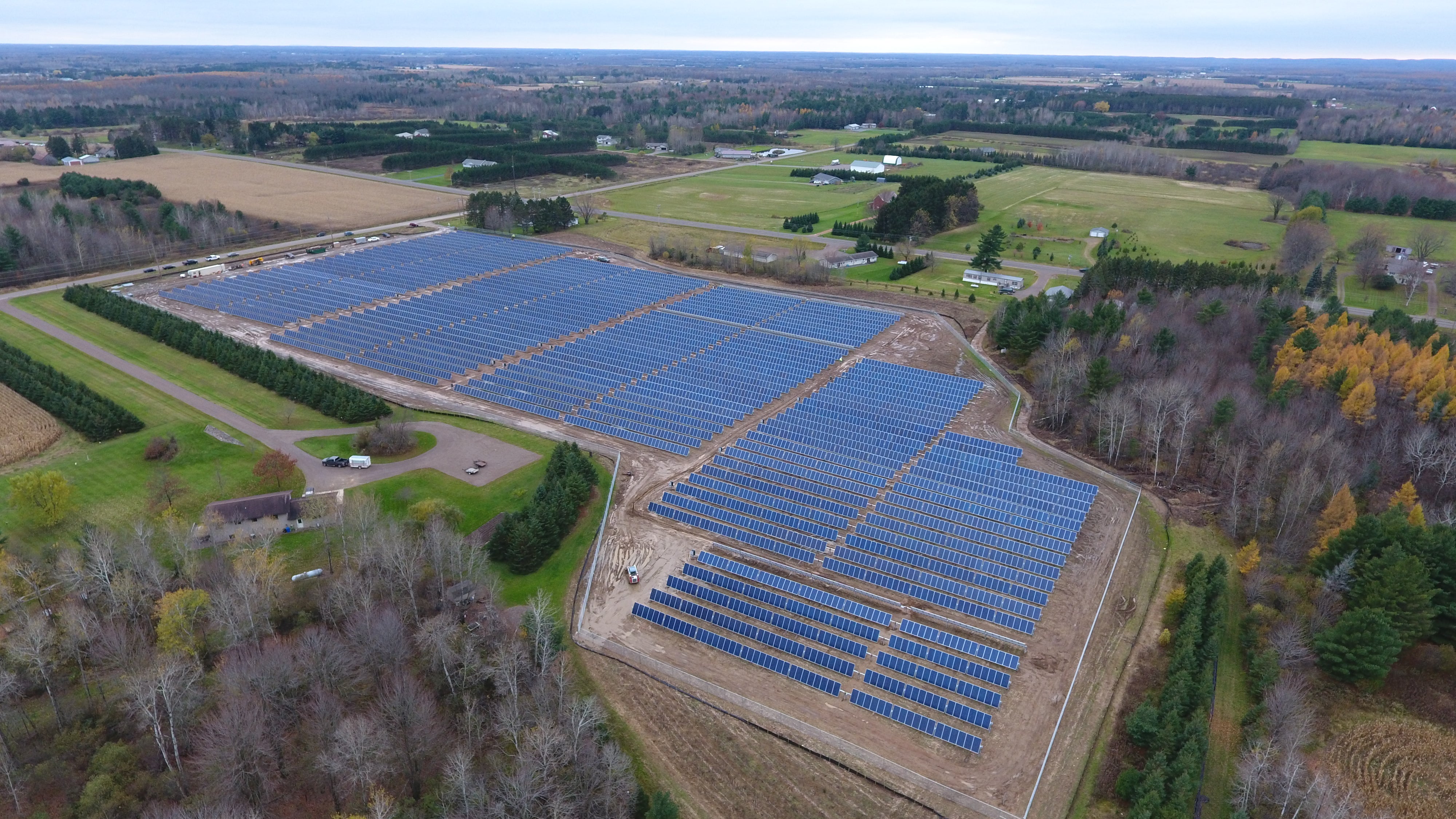 2016
2016
- Groundbreakings begin for the first of 15 utility-scale solar arrays to be sited within Dairyland's service territory. Dairyland has power purchase agreements in place with two developers - SoCore Energy (Chicago, Ill. - later known as ENGIE) and groSolar (White River Junction, Vt.) - to purchase more than 20 MW of renewable energy from the facilities in Wisconsin and Iowa.
- A total of three, 12-kW solar installations are construction at Alma Area School (K-12), Cochrane-Fountain City School (K-12) and De Soto Area Middle & High School. The installations are part of Dairyland's Solar for Schools initiative and are located near Dairyland power plant facilities. A fourth installation was added later in the year at Western Technical College's Independence campus, which supports students in electronics and energy management programs.
2015
- Dairyland commits to purchasing power from the 10 MW Sartell Hydro station (Sartell, Minn.)
- The new year begins with a new President and CEO in Barbara Nick. Nick replaces William Berg, who has led Dairyland since 1990 after first joining the cooperative in 1974.
2014
- Dairyland leads all Wisconsin electric providers by meeting 165 percent of the 2015 Wisconsin Renewable Portfolio Standard (RPS).
- Dairyland installs two 520-kW solar arrays at Vernon Electric Cooperative (Westby, Wis.) and People's Energy Cooperative (Oronoco, Minn.). The Westby site and other Dairyland solar locations would be recognized in early 2015 at RENEW Wisconsin's Energy Policy Summit.
- Alma Station Units 4 and 5 are retired and decommissioning of the site begins.
2013
- Nearly 14 percent of Dairyland’s Class A member sales came from renewable energy resources. Several hundred consumer-owned distributed renewable generation installations (photovoltaic and wind) are also sited in Dairyland’s service territory.
2012
- The U.S. Court of Federal Claims awards Dairyland damages of $37.6 million based on costs related to the federal government’s ongoing breach of contract regarding LACBWR, Dairyland’s shut-down nuclear facility. The Nuclear Waste Policy Act of 1982 gave the government responsibility for storage of the nation’s used nuclear fuel, with a deadline of Jan. 31, 1998, to begin accepting the fuel. The award to Dairyland represents costs incurred through 2006.
- Removal and transfer of the used nuclear fuel from Dairyland’s LACBWR shut-down nuclear facility to dry cask storage on the south end of the Genoa (Wis.) Site was completed. Final decommissioning of the LACBWR facility is commencing, and is expected to take five to seven additional years.
2011
- Wholesale power marketing entity GEN~SYS Energy was integrated into Dairyland.
- Three vintage 1950s coal-fired units of the Alma Station cease operation. Alma 1, 2 and 3 are part of the five-unit, 181-MW Alma Station, located in Alma, Wis. This move aligns with Dairyland’s generation resource plans that include the continued addition of renewable resources.
2010
- Dairyland integrates its more than 1,300 MW of capacity into the Midcontinent Independent System Operator (MISO) footprint. MISO, a regional transmission organization, manages one of the world’s largest energy markets.
- Dairyland begins purchasing the entire 40 MW output from the E.J. Stoneman Station biomass renewable energy facility. The power plant, owned and operated by DTE Energy Service, is capable of powering 28,000 homes in the Dairyland system with renewable energy.
2000s
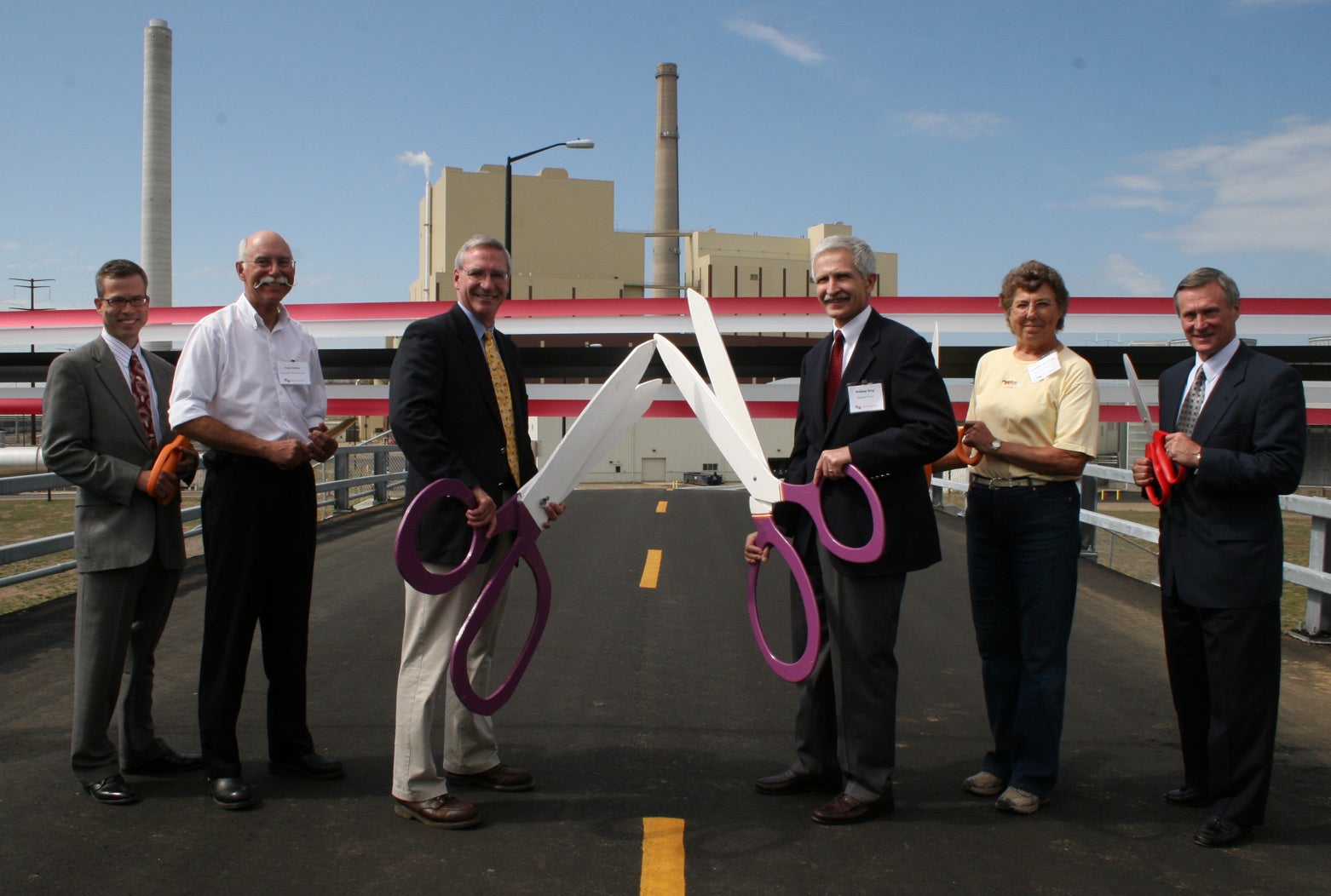 2008
2008
- The 525 MW Weston 4 power plant, of which Dairyland has a 30-percent ownership interest, achieved commercial operation. Weston 4 uses clean coal technology and sophisticated emission controls to minimize environmental impacts. Wisconsin Public Service Corp. is the majority owner of the plant, located near Wausau, Wis.
2007
- A key nuclear power plant decommissioning activity occurs, as Dairyland contracts with Energy Solutions, a national radioactive waste services contractor, to facilitate the removal and disposal of LACBWR’s Reactor Pressure Vessel and other low-level, non-fuel waste to a disposal site in South Carolina.
2006
- Private Fuel Storage, LLC,* a coalition of several utilities including Genoa Fuel Tech (a Dairyland subsidiary), receives a license from the Nuclear Regulatory commission to develop an interim spent nuclear fuel storage facility in Utah. *In 2012, the PFS Board of Directors voted to dissolve the organization, including termination of the license from the NRC.
- Dairyland is facing the near doubling of rail transportation costs, causing a 20 percent increase in wholesale energy costs. Dairyland supports legislation to correct railroad abuse and encourages increased competition for rail delivery from Powder River Basin coal mines.
- Dairyland’s first “cow power” facilities come online at Five Star Dairy (Elk Mound, Wis.) and Wild Rose Dairy (La Farge, Wis.).
2005
- Dairyland closes a deal with Wisconsin Public Service Corp., to purchase a 30 percent share of the 531 MW Weston 4 supercritical coal-fired facility under construction near Wausau, Wis. The $752 million facility is scheduled to be online in June 2008.
2004
- Landfill gas renewable energy is new to Dairyland this year. It is used to produce electricity at the Seven Mile Landfill Gas-to-Energy facility near Eau Claire, Wis.
2003
- Evergreen renewable energy program expands with additional wind generation from the McNeilus Wind Farm (Adams, Minn.).
2001
- The 95 MW Elk Mound Combustion Turbine power plant comes online. These two units are the first additions to the system since the John P. Madgett Station.
- The terrorist acts of September 11 cause Dairyland and the entire electric utility industry to re-evaluate and enhance security measures at power plants and other facilities.
2000
- After much preparation and testing, Dairyland and the electric utility industry entered Y2K quietly and reliably.
1990s
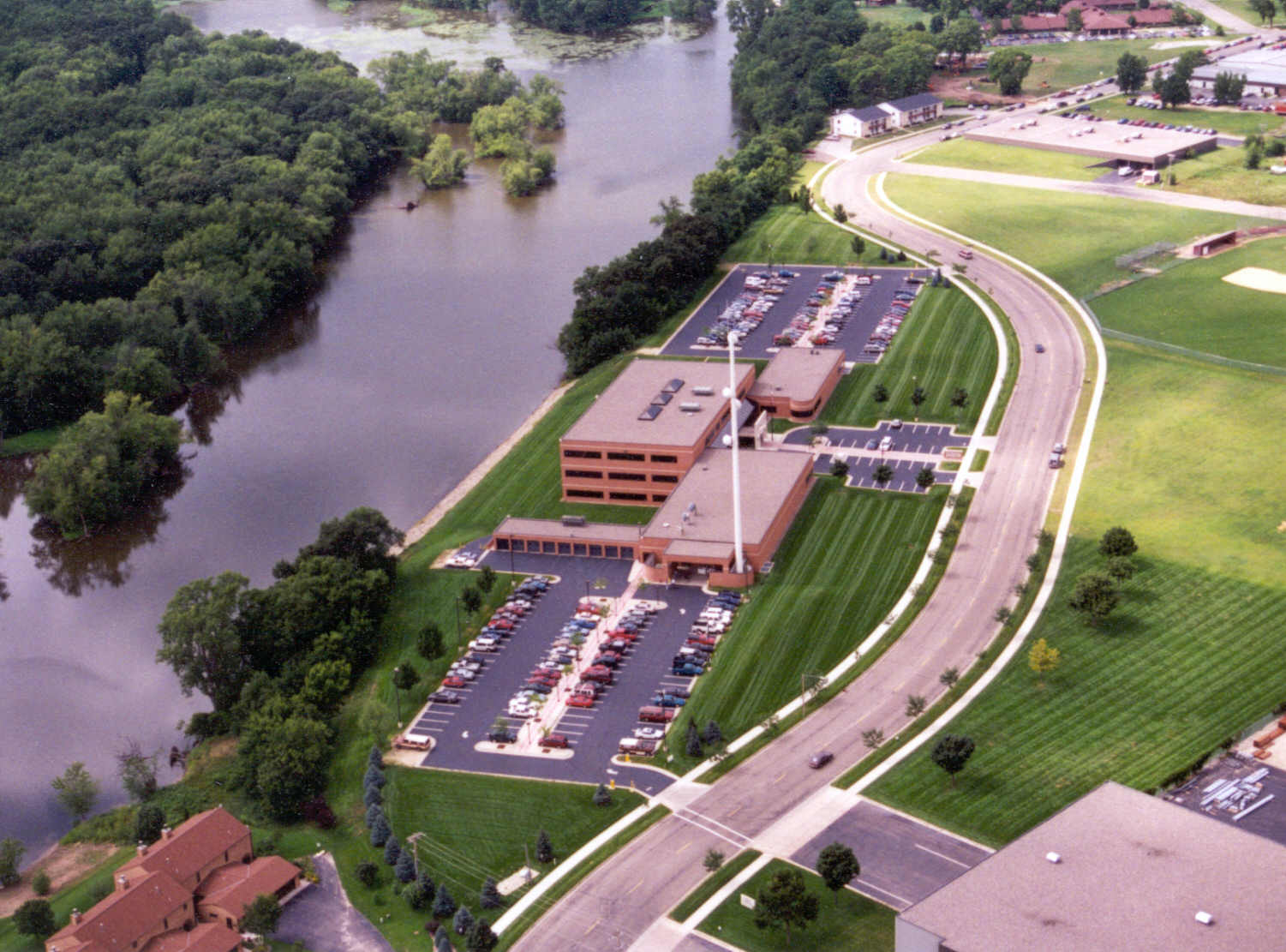 1998
1998
- Dairyland once again leads the way as a founding member of Touchstone Energy Cooperatives - a national brand promoting the power of rural electric cooperatives in their communities.
- Dairyland demonstrates its commitment to a clean environment with the launch of the EnPower Evergreen wind generation program.
- Dairyland’s members create EnPower to meet their growing marketing needs. One year later, EnPower consolidates with ESI, a Minnesota venture, focusing on off-system sales.
1997
- A pair of Peregrine Falcons call the nest box at the Alma Generating Station home and raise three chicks. The chicks are the first successful wild hatch of Peregrines in western Wisconsin in 25 years.
1996
- GEN~SYS Energy is created as a partnership between Dairyland and Cooperative Power, to maximize the value of their generation resources in the wholesale markets. Two years later, Dairyland buys out CP’s interest in GEN~SYS.
1994
- Dairyland installs its first Peregrine Falcon nest box 450 feet high on the stack at the Alma Generating Station.
1992
- As Johnny Carson gives his last bow as host of "The Tonight Show," Dairyland and its members explore new services, such as propane and Internet service.
1991
- At Dairyland’s 50th annual meeting address, Board President, Wayne Willink borrows from Thomas Edison’s business philosophy, “There’s a better way to do it … find it.”
1980s
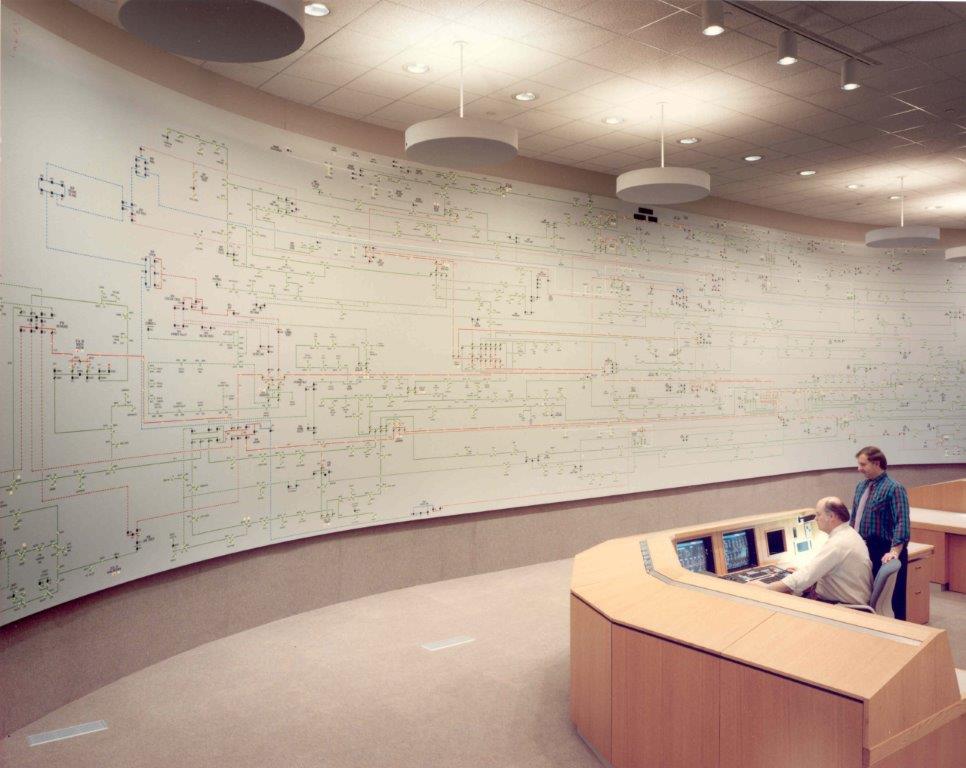 1989
1989
- As the nation cheers the fall of the Berlin Wall, Dairyland staff move into a modern, energy-efficient new headquarters, with a state-of-the-art System Operations Center.
1986
- Lower coal prices and surplus capacity contribute to the closing of the Twin Lakes diesel-fired plant. In 1987, the LACBWR ceases operations.
1982
- Dairyland organizes a voluntary load management program. One year later, compact discs are released to the retail music world.
1981
- Electrical growth in the Dairyland system is at an all-time low. Dairyland cancels plans to build a coal-fired facility planned for 1987, as the world watches the “fairy tale” wedding of Charles and Diana.
1970s
 1979
1979
- Alma #6 goes on-line at 350,000 kW (350 MW)and is named in honor of John P. Madgett. Better than eight years had passed from first proposal to power generation.
1974
- President Nixon resigns and new President Ford says that “our long, national nightmare is over.” One year later, Dairyland’s Class A sales decrease for the first time in 33 years.
1973
- Dairyland purchases the La Crosse Boiling Water Reactor (LACBWR) reactor for $1. The reactor’s operation and safety record was the best in the nuclear industry.
- The price of gasoline skyrockets from 35 cents to $1 per gallon. The price of coal increases 80 cents per ton, resulting in the first hike in delivered power cost since the ‘40s.
1971
- Environmental issues are a focus. After having spent $1.2 million on air pollution control at Genoa Station #3, plans were drawn for a $12 million environmental modification program.
1960s
 1969
1969
- Dairyland’s state-of-the-art, 350,000 kW Genoa Station #3 goes on-line. The massive base load plant generated nearly half of Dairyland’s power in the first year of operation.
- Apollo 11 lands on the moon, teenagers party at Woodstock and inflation soars. Dairyland has reduced the cost of delivered power by 47 percent since the late 1940s.
1966
- MAPP (Mid-Continent Area Power Planners) is formed with Dairyland’s urging. Dairyland moves to the suburbs as more people build homes outside city limits.
1963
- Dr. Martin Luther King is immortalized by his powerful “I Have a Dream” speech and President John F. Kennedy is assassinated. The next year, computers make their first appearance at Dairyland’s accounting department.
1960
- The Upper Mississippi Valley Power Pool is created, connecting Dairyland with power suppliers as far away as Nebraska, the Dakotas and Manitoba.
- Alma #5 goes on-line at 80,000 kW. Alma Station Units #4 and #5 utilize steam reheat systems that reduce fuel use and save over $500,000 a year.
1950s
 1956
1956
- Dairyland’s greatest expansion yet—a 161-kV line from Alma to People’s Cooperative in Rochester, Minn. The next year, a 161-kV line links Alma, Genoa and Cassville.
1951
- Blood, sweat and tears go into building a 70-mile, 161-kilovolt (kV) transmission line, tying Genoa to Alma, a groundbreaking achievement for construction crews.
1950s
- American spirits were high and the economy was flush. Fuel prices fell and electric sales rose for Dairyland, which brought seven generating units on-line during the decade.
1940s
 1947
1947
- Frank Linder leaves the REA and joins Dairyland as chief electrical engineer. In his position, he made plans for the transmission system which would later become standard for the REA.
- Alma Station Units #1 and #2 are brought on-line; the first power generated is sold to NSP.
1946
- The Baldwin Diesel Plant begins generating power.
- Post-war energy demands soar. Dairyland applies for a permit to construct a hydroelectric station on the Flambeau River near Ladysmith, Wis.
1945
- Dairyland commissioned the Vern Alden Engineering Firm to develop a long range plan—they recommend a $10.3 million construction program.
1941
- Just days after the bombing at Pearl Harbor, Tri-State and Wisconsin Power Cooperative merge to create Dairyland Power Cooperative.
- Amid a turbulent period during World War II, Tri-State’s 6,000 kW coal-fired station at Genoa, Wis., is completed.
1930s
 1938
1938
- Working together, 10 northern Wisconsin electric cooperatives create the Wisconsin Power Cooperative.
- Wisconsin Power Cooperative’s 2,100-kilowatt (kW) Chippewa Diesel Station becomes the first cooperative generating plant in the nation.
- Tri-State Power Cooperative is formed by five southern Wisconsin electric cooperatives.
1935
- President Franklin Roosevelt established the Rural Electrification Administration (REA) to help bring electricity to rural America. Electric cooperatives were created and arrangements were made to purchase power from generating plants and build power lines in rural areas. At long last, farmers could have convenient sources of electricity for small electric devices.
